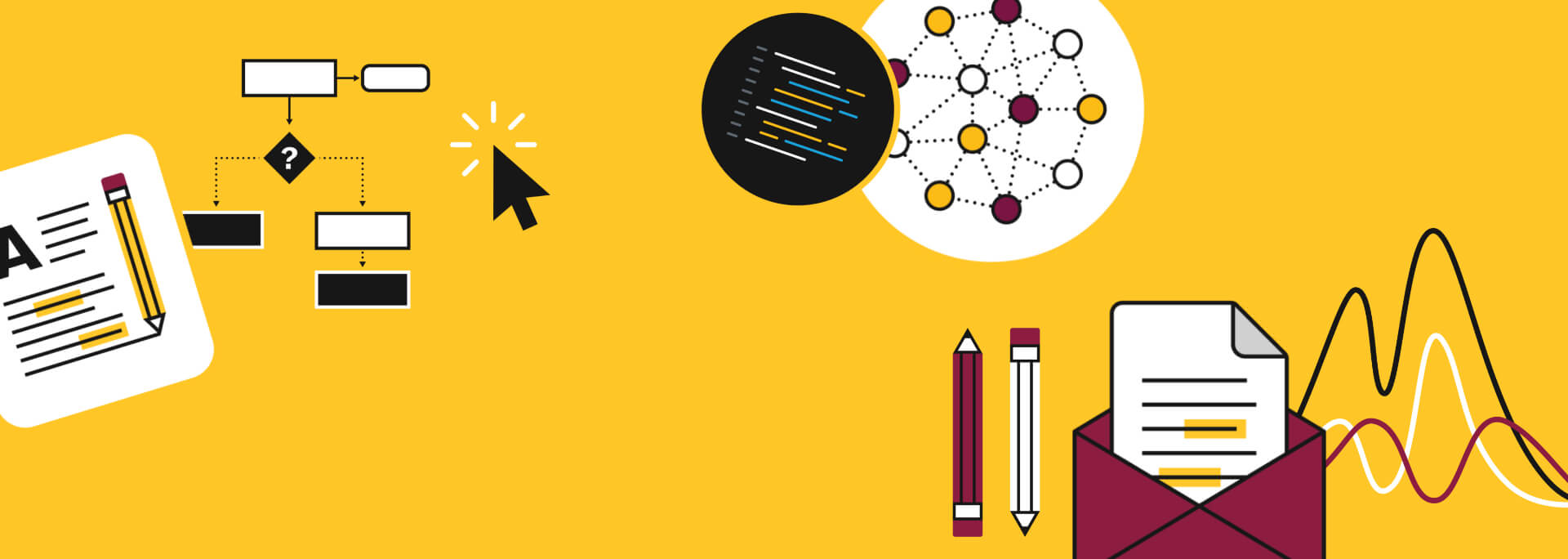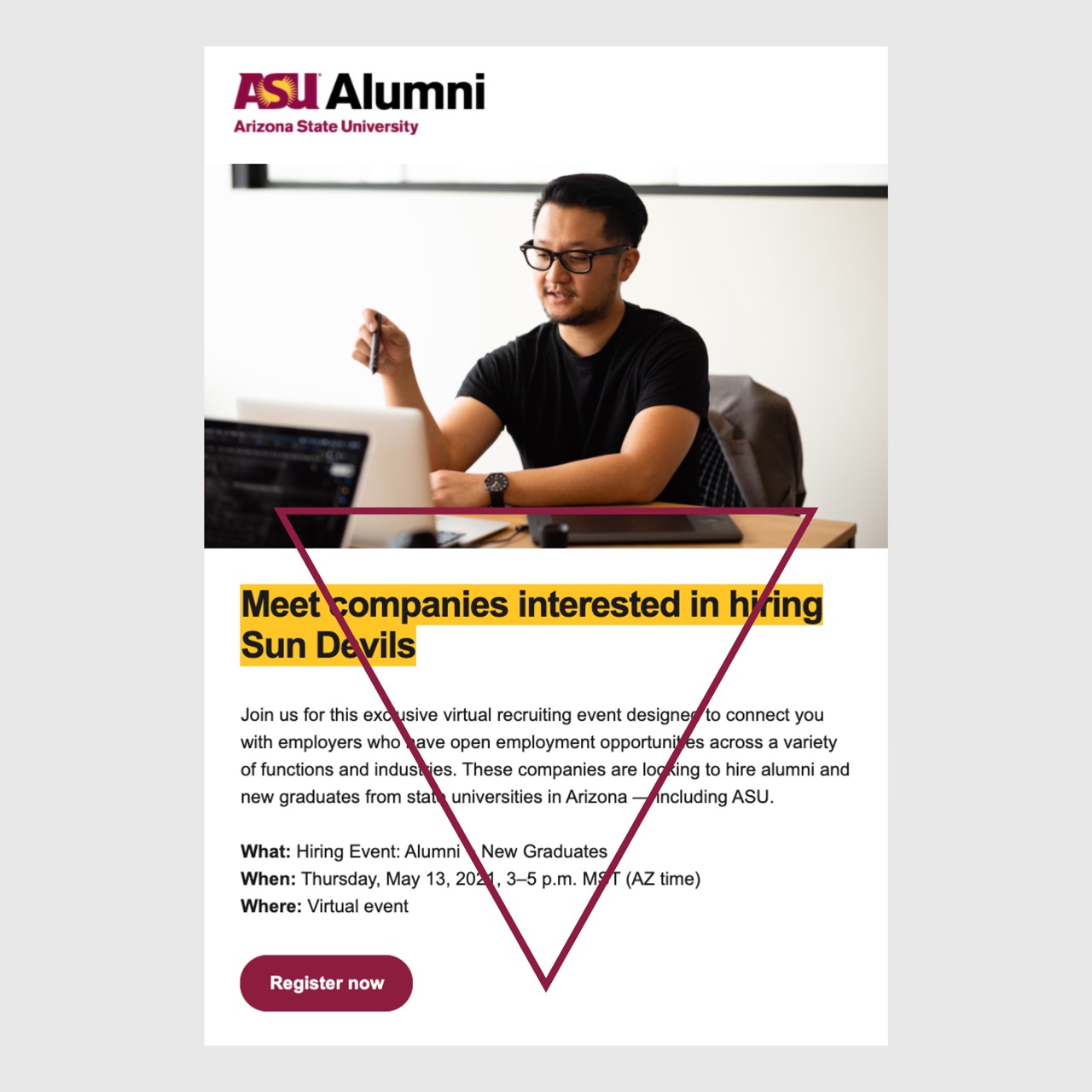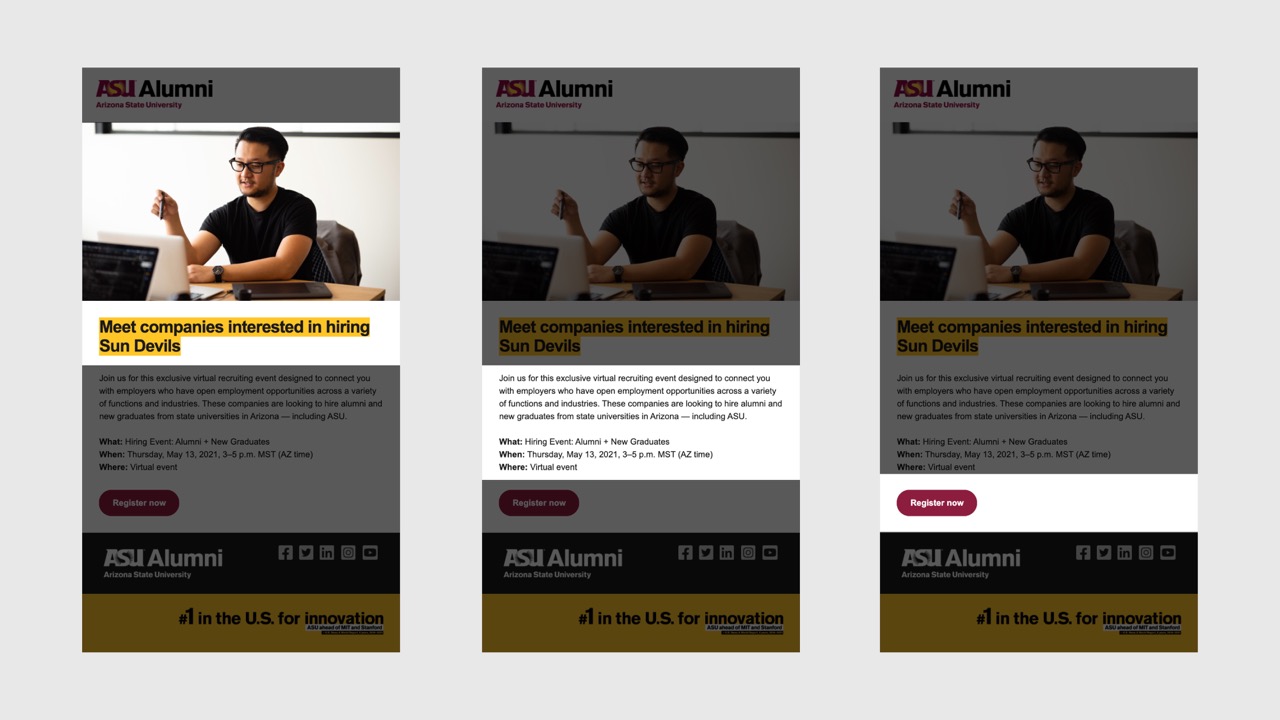Email has one of the highest returns on investment in the digital marketing and communications landscape. The trust that your audience has with you is nowhere stronger than in their inbox. They’ve given you permission to come directly into their world, and expect relevant, useful, nonintrusive content to help them make decisions and stay connected to the ASU brand.

Brand execution guidelines
Email content best practices
Consider the following when crafting email content
- Know the cost of your email campaigns.
- Contrary to popular belief, email isn’t “free.” Just because you can write, build and hit send on a campaign without having to pull out your wallet doesn’t mean that there isn’t an emotional and relationship cost with each email you send.
- There is a reason the word “spam” comes from email communications — and no one wants to be “spammy.” Each email campaign you send to your audience is a touchpoint with the ASU brand. It needs to be relevant, timely and helpful.
- Know why you’re sending the email. What’s the goal?
- What/how/when/why does your audience want to hear from you? What are you hoping to achieve with this email campaign?
- Ask yourself these questions before hitting send on any email. Consider implementing a knowledge or creative brief (like the one the Brand team has created) before executing an email campaign that answers these important questions, so everyone is on the same page about what is expected from the email channel.
- Get to know your audience even deeper by referring to industry reports, historical email data and even by asking them what they want to hear from you.
- Know if email is even the right channel for you — is your audience more likely to follow you on social media than open an email from you? Meet your audience where they are and give them what they’re asking for.
- Help your audience get to know you.
- Use a consistent and easily recognizable “from” name and email address that describes you and your unit. Personalization works, but make sure to include context about who the sender of the email is, especially to new audiences or when coming from new people in your unit. For example, sending from Christine Wilkinson, ASU Alumni Association to newly graduated alumni increases transparency and provides context about who the email is from.
- Be as straightforward as possible to provide a trustworthy relationship.
- Use clear subject lines that let readers know what to expect inside.
- There is a benefit to piquing interest in an email just enough to prompt someone to want to find out more, but don’t be overly mysterious or outright misleading. This can harm your credibility and trustworthiness with your audience, and could get you flagged as spam.


- Structure your content using the inverted pyramid.
- Start by grabbing their attention with an image or headline.
- Provide more information and context about the purpose of the email.
- Close with a button or call to action.
- Attention spans are shorter than you may think.
- In the Brand team's research, the average time spent reading an email is eight seconds.
- Get your audience the message they need right away, or you’ll lose their interest.
Tips for structuring email content
Commercial emails
Learn more about what qualifies an email as commercial.
- Subject line:
- Subject lines should be about 25 characters long. Your important information may be cut off if it’s much longer than this.
- Include a question that will entice readers to find the answer inside.
- Use personalization such as a first name merge field/AMPscript.
- Preheader:
- A preheader is the copy a recipient sees as the “preview” text of your email content, below the subject line in an inbox.
- You should always include a preheader to avoid the first line of text showing as a default (e.g., “ASUlogo.jpg”).
- The preheader should be no more than 90 characters long. This is the optimal length for filling two rows of preview text under the subject line in most email service providers.
- It should support the subject line, but not contain any critical piece of information that the audience might miss. As this is just a preview, this copy isn’t accessible within the body of the email.


- Headline:
- Include a headline to introduce the content of your email.
- This increases scannability and draws readers into the rest of the copy.
- Character count for headlines should generally be less than 50 characters (or no more than two lines, whichever is less). Because of the large and bold nature of the headline, more text could fill up the majority of a user’s screen and become invasive.
- Body copy:
- Keep text as brief and scannable as possible.
- Character count for body copy should generally be less than 1,000 characters. Attention spans are shorter than you may think. Make sure your audience is able to easily digest the most important parts of your email quickly.
- Use short paragraphs to increase scannability. Walls of long text are difficult to digest, so break your content up into as many small paragraphs as possible.
- Be mindful of the number of links you’re including in the email. It should generally be less than three for most types of email communications. Keep the goal of your email in mind. If someone clicked on one link, which would it be? Optimize for that link.
- Use ASU writing style.
- Avoid language that will trigger spam filters, such as:
- Writing in ALL CAPS
- Lots of exclamation points!!!
- Words that make exaggerated claims and promises
- Words that create unnecessary urgency and pressure
- Words that look like shady, spammy or unethical behavior
- Words that are jargon or legalese
- Be clear about the purpose for the email (refer back to your creative brief and the goal of the email).
- Bullet points are a great option to help readers quickly consume the key points or elements of your message.
- Bold any items that you want to stand out when a reader quickly scans your email content, such as dates, times or key concepts and messages (but not everything).
- Calls to action:
- It helps to close with a brief, clear call to action.
- Use a button whenever possible.
- CTAs should be about two to four words.
- They should be action-oriented verbs, such as “Learn more,” “Register now,” etc.
Transactional emails
Learn more about what qualifies an email as transactional.
- Subject line:
- Subject lines should be about 25 characters long. Your important information may be cut off if it’s much longer than this.
- Be transparent about the nature of the email (e.g., “Your order confirmation,” “Thanks for signing up”).
- Body copy:
- Should not be commercial or promotional in any way. By law, transactional emails are one-to-one emails that contain information that completes a transaction or process the recipient has started with you.
Letter-type format emails
- From name and email address:
- Should be the name of the person the email is from, with context (e.g. Christine Wilkinson, ASU Alumni Association).
- Should be the name of the person the email is from, with context (e.g. Christine Wilkinson, ASU Alumni Association).
Body copy:
- It is helpful to include a first name merge tag field/AMPscript to increase personalization.
- It can also be helpful to include a signature block, image of a signed signature or image of the person the email is from.
Additional resources